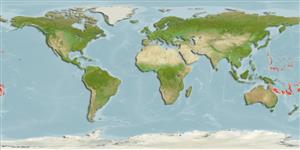Environment: milieu / climate zone / depth range / distribution range
Ökologie
seewasser; süßwasser; brackwasser demersal; amphidrom (Ref. 51037); tiefenbereich 1 - 1000 m (Ref. 58302). Tropical; 30°N - 25°S, 140°E - 160°W
Oceania: Mariana Islands south to Vanuatu, New Caledonia and Fiji.
Length at first maturity / Size / Gewicht / Alter
Maturity: Lm ?, range 7 - ? cm
Max length : 24.5 cm SL Männchen/unbestimmt; (Ref. 26668); 16.5 cm (female)
Benthic (Ref. 58302). Adults occur from lowland streams and rivers to relatively swift streams at elevations of 1000 m. They often burrow into the substrate with only the eyes showing; feed on filamentous algae, worms, crustaceans, various insects and insects larvae, and suspended food particles; has been long favored as food by the early Hawaiians (Ref. 44091). Larvae develop and metamorphose in the marine zooplankton and as juveniles, about 161 days old, recruit to freshwater streams, where they undergo rapid growth and morphological changes necessary for upstream migration to the adult habitat (Ref. 51037).
Adults move downstream to their prime breeding just above the estuary; males select crevices and caves formed by rocks on the stream bed where the females will lay their eggs; males guard nests until larvae hatch a day later (Ref. 44091).
Watson, R.E., 1992. A review of the gobiid fish genus Awaous from insular streams of the Pacific Plate. Ichthyol. Explor. Freshwat. 3(2):161-176. (Ref. 26668)
IUCN Rote Liste Status (Ref. 130435)
Bedrohung für Menschen
Harmless
Nutzung durch Menschen
Mehr Information
ReferenzenAquakulturAquakultur ProfilZuchtlinienGenetikElectrophoresesVererbbarkeitKrankheitenVerarbeitungNutrientsMass conversion
Tools
Zusatzinformationen
Download XML
Internet Quellen
Estimates based on models
Preferred temperature (Ref.
123201): 9.2 - 23.2, mean 15.6 °C (based on 54 cells).
Phylogenetic diversity index (Ref.
82804): PD
50 = 0.5000 [Uniqueness, from 0.5 = low to 2.0 = high].
Bayesian length-weight: a=0.01122 (0.00570 - 0.02208), b=3.11 (2.95 - 3.27), in cm total length, based on LWR estimates for this species & Genus-body shape (Ref.
93245).
Trophic level (Ref.
69278): 2.2 ±0.1 se; based on diet studies.
Widerstandsfähigkeit (Ref.
120179): mittel, Verdopplung der Population dauert 1,4 - 4,4 Jahre. (Assuming tm=1-2 and Fec<1000).
Fishing Vulnerability (Ref.
59153): Low vulnerability (11 of 100).
